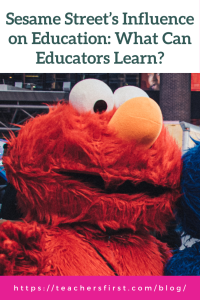“It’s not whether children learn from television, it’s what children learn from television…because everything that children see on television is teaching them something.”
– Joan Ganz Cooney, co-creator of Sesame Street
On November 10, 1969, Sesame Street made its television debut. Sesame Street. This revolutionary show has taught generations of young children various skills, from the alphabet and counting to self-regulation and executive functioning. What isn’t always known about Sesame Street is that its fruition came from a mission to foster preschoolers’ “intellectual and cultural development” through a research-based curriculum. So it’s no wonder this show has been successfully running for over 50 years now in more than 120 countries.
Sesame Street creators Joan Ganz Cooney and Lloyd Morrisett were ahead of their time when they reimagined how television could be meaningful educational media. As educators in the 21st century, where all forms of media are at our students’ fingertips, we are also navigating that same mission. So, what can educators learn from Sesame Street?
If we take on the challenge of creating meaningful learning through media, it’s good to review facts first, just like the creators of Sesame Street did. They recognized the resounding statistics of television’s media dominance at the time and designed it around that. We must do the same with what we know about current media consumption statistics of young children. The Common Sense Census: Media Use by Tweens and Teens, 2021 research report, found that 8- to 12-year-olds use about five and a half hours of screen media per day, while 13- to 18-year-olds use about eight and a half hours daily. This probably isn’t a surprising statistic to most of you. Still, it reminds us of how important it is for educators not to forget digital media’s impact on student engagement. Furthermore, it brings to light the necessity of discussing topics like media literacy and digital citizenship before diving deep into integrating media and technology in the classroom.
Teaching media literacy (the ability to identify various media types and analyze the messages they’re sending) empowers students to better understand and participate in the digital media world. In addition, students are constantly drawing connections between what they consume online and what they learn at school. So, it’s pivotal that educators prioritize teaching students media literacy skills that help them make valuable connections. Check out our blog post about Media Literacy Week for resources on engaging students in these types of discussions.
Along the same lines of media literacy is digital citizenship. Digital citizenship teaches students to use technology safely, responsibly, and ethically. Digital citizenship should also be a part of the foundation you set when using media for educational purposes, especially if you’re interested in using collaborative learning platforms like Flip (reviewed here), Padlet (reviewed here), or Seesaw (reviewed here). How can we expect students to give their peers appropriate constructive comments online if their only experience with that type of interaction is on social media apps or gaming sites? Having discussions about digital citizenship before those types of activities can save time dealing with potential conflicts and create a safe learning environment for students. We have several articles on our TeachersFirst blog covering digital citizenship topics that can help you start this discussion. In addition, Edpuzzle (reviewed here) has recently added a series of digital citizenship content to their Edpuzzle Originals library.
Lastly, I think the most important lesson we can learn from Sesame Street is the intentionality that goes into creating each episode and learning experience. According to Ben Lehmann, Sesame Street’s executive producer, the curriculum team consults with child development, child psychology, and preschool experts at the start of each new season. Now, I know we can’t always consult with experts in the education field whenever we want to create an educational media learning experience. But, we can try our best to cultivate a group of professionals willing to collaborate with us, give us feedback, and help ensure that our learning design is the best it can be. For example, last month, we shared a blog post about Creating a Culture of Community in Your School. Collective communities of teachers can create significant change in classrooms. You can also turn to the TeachersFirst community to help with lesson planning and instructional design. The more intentional we can get with how we use media in our classrooms, the greater its impact on students’ learning.
If you’re interested in learning more about the research and work of Sesame Street, visit Sesame Workshop online. You can also pursue hundreds of Sesame Street videos on PBL Learning Media to use with your students. Let us know what you learn in the comments below!


